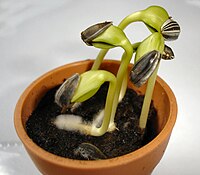
Photo from wikipedia
Mitochondria play key roles in cellular-energy metabolism and are vital for plant-life, such as for successful germination and early-seedling establishment. Most mitochondria contain their own genetic system (mtDNA, mitogenome), with… Click to show full abstract
Mitochondria play key roles in cellular-energy metabolism and are vital for plant-life, such as for successful germination and early-seedling establishment. Most mitochondria contain their own genetic system (mtDNA, mitogenome), with an intrinsic protein-synthesis machinery. Although the challenges of maintaining prokaryotic-type structures and functions are common to Eukarya, land plants possess some of the most complex organelle composition of all known organisms. Angiosperms mtDNAs are characteristically the largest and least gene-dense among the eukaryotes. They often contain highly-variable intergenic regions of endogenous or foreign origins and undergo frequent recombination events, which result in different mtDNA configurations, even between closely-related species. The expression of the mitogenome in angiosperms involves extensive mtRNA processing steps, including numerous editing and splicing events. Why do land-plant’s mitochondria have to be so complex? The answer to this remains a matter of speculation. We propose that this complexity may have arisen throughout the terrestrialization of plants, as a means to control embryonic mitochondrial functions —a critical adaptive trait to optimize seed germination. The unique characteristics of plant mtDNA may play pivotal roles in the nuclear-regulation of organellar biogenesis and metabolism, possibly to control embryos quiescence or dormancy, essential determinants for the establishment of viable plantlets that can survive post-germination.
Journal Title: Plants
Year Published: 2020
Link to full text (if available)
Share on Social Media: Sign Up to like & get
recommendations!